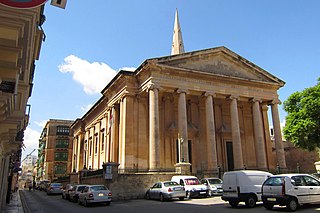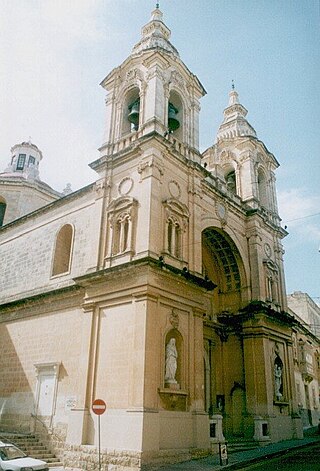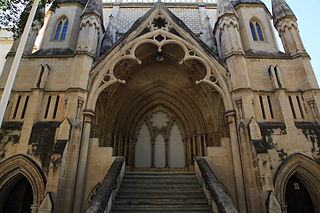
Sliema is a town located on the northeast coast of Malta in the Northern Harbour District. It is a major residential and commercial area and a centre for shopping, bars, dining, and café life. It is also the most densely populated town on the island.

Westbury on Trym is a suburb and council ward in the north of the City of Bristol, near the suburbs of Stoke Bishop, Westbury Park, Henleaze, Southmead and Henbury, in the southwest of England.

The Cathedral of the Holy Trinity is the cathedral for the Church of England Diocese of Gibraltar in Europe. Located in Cathedral Square, it is sometimes referred to simply as Gibraltar Cathedral, although it should not be confused with the Cathedral of St. Mary the Crowned, which is Gibraltar's Roman Catholic cathedral. The cathedral is particularly notable for its Moorish revival architecture, particularly in its use of horseshoe arches. This is an architectural style inspired by Moorish architecture, appropriate given the period of Moorish control in Gibraltar's history.

St Paul's Pro-Cathedral, officially The Pro-Cathedral and Collegiate Church of Saint Paul, is an Anglican pro-cathedral of the Diocese in Europe situated in Independence Square, Valletta, Malta. A "pro-cathedral" is a church with cathedral status though not being the main cathedral. It is one of three cathedrals of the Anglican Diocese of Gibraltar in Europe.

Maltese architecture has its origins in prehistory, and some of the oldest free-standing structures on Earth – a series of megalithic temples – can be found on Malta. The islands were colonized by the Phoenicians and later the Romans, who established the cities of Melite and Gaulos. Although these were substantial settlements and are known to have had numerous temples, churches and palaces, few remains have survived apart from some architectural fragments.

Holy Trinity Church stands to the north of the village of Bickerton, Cheshire, England. The church is recorded in the National Heritage List for England as a designated Grade II listed building. It is an active Anglican parish church in the diocese of Chester, the archdeaconry of Chester, and the deanery of Malpas. Its benefice is combined with those of St Wenefrede, Bickley, St John, Burwardsley and All Saints, Harthill.
Ambrose Walter Marcus Weekes was an Anglo-Catholic bishop in the 20th century who served as the first Suffragan Bishop in Europe.

Holy Trinity Church is a church in Market Street, central Cambridge, England, on the corner with Sidney Street. Its current vicar is Stuart Browning. Theologically, it stands within the charismatic evangelical tradition of the Church of England.

The Stella Maris Parish Church is a Roman Catholic parish located in Sliema, Malta. It is the matrice of the other parish churches in Sliema and Gżira being the oldest parish church dating from 1878.

Walter John Trower FRSE was an Anglican bishop.
Among the places of worship in the town and area of Malvern, Worcestershire are centres of dedication to many faiths and denominations. The town has 31 Christian churches with 11 belonging to the Church of England, ranging from low church to high Anglo-Catholic, two Roman Catholic, one Evangelical, and the others being Non-Conformist and other faiths. Its oldest place of worship is the almost cathedral sized parish church of Great Malvern Priory which is all that remains of the former 10th century abbey in central Malvern, which according to the Worcester Monastic Annals, work began in 1085. The chain of Malvern Hills lies in a north-south direction, thus posing a challenge for the architects of Christian churches located on the steep slopes, chancels being traditionally sited at the east end of the building. Many churches were built in the 19th century concomitant with the rapid expansion of the town due to its popularity as a spa. A few modern buildings such as St Mary's Church (1960) in Sherrard's Green, have been constructed in the second half of the 20th century, and some churches, notably St Andrews in Poolbrook, have had important modern extensions added during the first decade of the 21st century.

St Matthew's Church is in St Matthew's Street, Burnley, Lancashire, England. It is an active Anglican parish church in the diocese of Blackburn. The original church was built between 1876 and 1879, and was designed by William Waddington and Sons. This burnt down in 1927 and was replaced by the present church. In the 1970s St Matthew's joined with the neighbouring Holy Trinity Church.
The archdeacons in the Diocese in Europe are senior clergy of the Church of England Diocese in Europe. They each have responsibility over their own archdeaconry, of which there are currently seven, each of which is composed of one or more deaneries, which are composed in turn of chaplaincies.

Holy Trinity Church is a historic Catholic parish church in Chipping Norton, Oxfordshire, England. It is situated on the London road in the centre of the town. It was built in 1836 and is a Grade II listed building.

Sliema Point Battery, also known as Fort Sliema, is an artillery battery in Sliema, Malta. It was built by the British between 1872 and 1876. The battery stands on the peninsula that separates Marsamxett Harbour from St. Julian's Bay. The battery was later used as a searchlight position, and it is now a restaurant known as Il-Fortizza.

The Robert Samut Hall is a late 19th-century defunct Methodist church, formerly named Wesleyan (Methodist) Church, now a state owned building in Floriana, Malta.
Webster Paulson was an English civil engineer who is known for his work in Malta in the late 19th century.

Andrea Vassallo was a Maltese architect. He designed buildings in various styles, including Neoclassicism, Rococo Revival, Neo-Gothic, Art Nouveau and Neo-Romanesque. His masterpiece is the basilica of Ta' Pinu in Gozo, while other notable works include the domes of the Ħamrun and Siġġiewi parish churches, Villa Rosa and the now-demolished Casa Said.

Fatima House, formerly Villa Bétharram, is a late nineteenth-century villa at 65 High Street, Sliema, Malta. It was purposely built as a family residence for the Galea family, on request of Maltese Senator Alfonso Maria Galea. It is now a residence for females in social needs, sometimes known as Fatima Hostel or Fatima Working Girls' House.

The Jewish Cemetery is a cemetery in Marsa, Malta. It was established in December 1879, and it was built to designs of the English architect Webster Paulson.


















